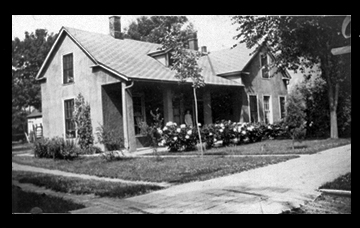Big Grandma, my mother’s mother, wasn’t really very big, not
much more than 5 feet tall; but she was bigger than Little Grandma, my father’s
mother, who was a tiny woman.
After we moved to the Chicago
area, when we’d visit St. Paul, we’d
stay with Big Grandma. To a little girl
who visited only once a year, her house was full of places I longed to explore
but I wasn’t allowed to investigate - places that must surely contain all
manner fascinating things.
The house was one of the earliest built in that part of St.
Paul. Additions had been made by the time my
grandparents bought it in 1920. It still
sits on Goodhue Street on
the limestone bluff at the lower end of the old High
Bridge. The basement had been carved or blasted out
of the limestone. There was a coal fired
furnace down there; and probably storage for meat and vegetables. I’m sure that the limestone kept the
temperature more or less constant summer or winter.
Early photo – before my time
The High Bridge
connected the high bluffs of the wide gorge carved from the stone by the Mississippi
river. At the river’s level
were still some homes, some industry, and a railroad yard.
The house itself was quite unremarkable. It was green painted stucco. There were large
shade trees in the front yard. Around
the side was a pretty plot of lily of the valley. I loved those tiny fragrant white flowers.
The back yard included a chicken coop that was empty by the time I saw it. When her family was at home, Grandma raised
chickens and ducks. She used duck eggs
in her baking because they were richer than chicken eggs. Also in the backyard was Grandpa’s shed!
How I longed to investigate all the wonderful things stashed
away in that shed! Grandpa died before I was born so I never knew him. He’d been a teamster with his own team of
horses; and the shed had housed the horses, his wagon, and all his tack and
tools. I was actually inside the shed a
few times but never let loose to explore.
There were horse collars and other tack hanging on one wall. There was a
grinding wheel for sharpening tools. I loved its smell of old wood and old
leather.
The interior of the house was plain, functional, and felt
very comfortable to me. Nothing fancy, but
I sure wish I had photos of its old fashioned furnishings. There was a player piano with at least a
dozen music rolls. I couldn’t play the rolls, but I was allowed to occasionally
play the piano. I learned decades later
that one of my cousins resented me because Grandma let me sometimes play
it.
Hanging on the wall above the piano were portraits of two
beautiful young women – 1920’s glamour portraits of two of my aunts. I found that hard to believe because by the
time I knew them, they were already in their 40’s which meant “old” in my young
eyes.
There was a small room that had a toilet but it had no other
plumbing. It also had a box of newspapers for bathroom reading. Bathing was done in the kitchen in a big, round
galvanized tub that was brought out for baths and for laundry.
The kitchen had a sink with a drainboard and single faucet
for cold water. Hot water for
dishwashing, bathing and laundry was heated on the cook stove. It was a huge black coal fired iron
stove. Grandma had cooked and baked for
her family and taught her seven daughters to cook on that stove. To the right of the stove there was a large
pantry that excited my curiosity because the upper shelves held lots of
interesting looking things. I never got to explore it. A room to the left of
the stove held a large ice box among other things.
The long wide dining room held a sturdy table that would
seat the whole family: parents and their 11 kids. By the time I arrived, the only kids around
were grandchildren and even some of them were already adults. On one wall was a
big old clock with a brass pendulum and a pretty loud tick. It’s chime struck
every quarter hour and tolled the hour. Off to one side was a nook with a small
table and a chair. On the table was a
candlestick phone.
The rail yard at the base of the bluff was probably always
pretty busy but I only noticed the trains at night. I’d fall asleep to the ticking of the dining
room clock and then, in the darkness, the whole house would begin to vibrate as
a train pulled by a chugging steam engine would resonate through the
limestone. I can still feel it.
I remember being upstairs at Grandma’s house only once. As usual, I wasn’t allowed to explore. There
were chests full of things that Grandma had kept and that aunts and uncles had
left behind. Imagine what treasures were
tucked away just waiting for a little girl to find them.
Our annual visits stopped in 1953 after my first brother was
born; and when Grandma died in 1954, the house was emptied and sold. To this day I still wonder what amazing
things I might have found in the forbidden (to a little girl) spaces of Big
Grandma’s house.
